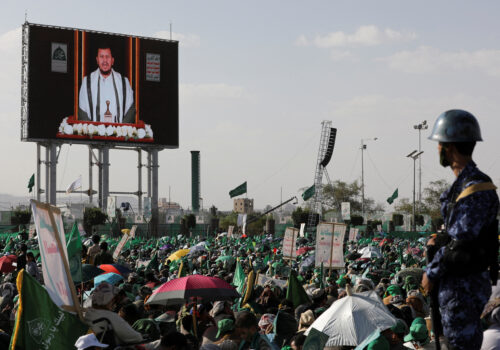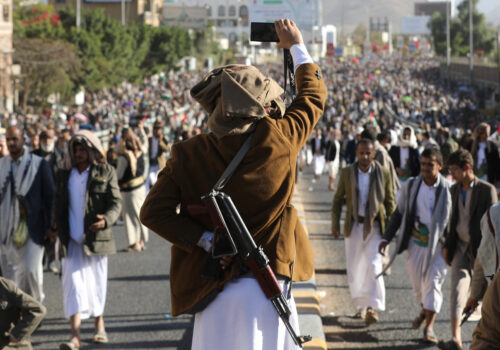Do the Houthis really have a hypersonic missile?
On September 15, the Iranian-supported Houthi rebels launched a ballistic missile at Israel—the group’s longest-range attack on Israeli territory to date. The projectile, which fell in an open area near Ben Gurion International Airport, caused no casualties and only material damage. In the hours after the attack, Houthi leadership made some outlandish claims about the strike, including that the weapon was a hypersonic missile—a term used for missiles capable of traveling at least Mach 5, or five times the speed of sound. The claim is concerning for more than just the high speeds; unlike traditional ballistic missiles that follow a predictable path, hypersonic missiles can maneuver during flight, making them difficult for missile-defense systems to intercept.
While an Israeli Defense Forces (IDF) official denied that the missile was capable of hypersonic speeds, Houthi officials would later report that the missile had traveled more than 2,000 kilometers at speeds of Mach 9. Moreover, the Houthis doubled down and released a two-minute video of them launching the missile, dubbed the Palestine-2, which had the word “hypersonic” clearly written in English on the side of the weapon. They also claimed that the Palestine-2 missile has a range of up to 2,150 kilometers, operates on two-stage solid fuel, has some form of “stealth technology,” and can reach speeds of up to Mach 16. The Houthis also alleged that the system was able to evade most advanced air-defense systems, including the Israeli Iron Dome.
SIGN UP FOR THIS WEEK IN THE MIDEAST NEWSLETTER
Houthi claims about this advanced technology should be treated with much skepticism. At this time, only the United States, China, India, and Russia have demonstrated hypersonic capabilities. The fastest hypersonic weapon—the Russian Zircon missile—can only travel at speeds of Mach 8 and with a range of 1,000 kilometers. Given international sanctions and arms embargoes on the Houthis and Iran, it is doubtful that the rebels—or their backers in Tehran—could develop a system that is roughly twice as powerful as the one developed by the Russians. Moreover, Iran often exaggerates its military successes. In just one example, Tehran claimed to have developed a stealth fighter aircraft known as the Qaher-313; it was later revealed to be a mockup that was likely incapable of flight.
Even if Iran has managed to develop hypersonic capabilities, it is unlikely that it would have transferred such weaponry to the Houthis. The high costs associated with developing these systems and mass producing such technology would mean that such an advanced weapon would be in short supply and kept for Islamic Revolutionary Guard Corps (IRGC) use. If the IRGC decided to transfer some of its limited supply, the weapons would likely not be destined for the Yemeni rebels. Despite receiving support from the regime for more than a decade—as demonstrated by Houthi cross-border attacks against the United Arab Emirates (UAE) in 2022 despite a recent rapprochement between Iran and the UAE—the Houthis still have a fair degree of independence from Iran. If the weapons were transferred, they would likely go to another group that is more squarely under regime control, such as Hezbollah in Lebanon.
But that hasn’t stopped the Houthis or the IRGC from claiming otherwise. In March, a Russian report contended that the Yemen-based rebels possessed a hypersonic missile that ran on solid fuel and was capable of reaching speeds of Mach 8. It also claimed that the group intends to start manufacturing the system to use it in attacks on Red Sea shipping and Israeli territory. For its part, the IRGC has been claiming since at least 2022 that it has developed a hypersonic weapon capable of speeds up to Mach 15 and a range of 1,400 kilometers. Despite no reports of the first version of such a weapon being tested, the IRGC unveiled an “upgraded” version of its Fattah hypersonic missile a little more than a year later. Some outlets even alleged that Iran had fired these Fattah missiles during its April 14 attack on Israeli territory and that the systems had evaded Israeli air-defense systems. It’s worth noting that the images of the Houthis’ Palestine-2 rocket closely resemble the Iranian Fattah, which would make sense given Tehran’s history of providing the rebels with weapons and weapons components.
But just because the missile was not hypersonic does not mean the attack should be disregarded. In fact, three critical details make it an important inflection point in the Houthis’ offensive against Israel and Israeli interests. First, the missile was the longest-recorded attack on Israeli territory from Yemen, with even non-Houthi reports estimating the missile flew more than 1,900 kilometers before crashing, putting new Israeli targets into range. Second, the system was able to at least partially avoid Israeli air-defense systems, as initial Israeli Air Force assessments found that its Arrow system hit, but did not fully destroy, the missile. Finally, among other things, the Houthis repeatedly alleged that the system used solid fuel, which is significant if true because solid-fuel missiles take less time to set up and fire than those with liquid fuel, making them harder for the United States and allied forces to target.
With the Houthis threatening additional attacks ahead of the anniversary of Hamas’s October 7, 2023, assault on Israel, the United States, Israel, and their allies in the region should be prepared for more attacks. Although the United States has sent additional ballistic missile-defense-capable cruisers and destroyers, as well as a fighter squadron and more land-based ballistic missile defenses, efforts to intercept Iranian weapons and weapon components in transit to the Houthis need to take a greater priority. Even the United States has commented that Iran is sending an “unprecedented” amount of weaponry to the rebels. Given that these attacks work to legitimize the Houthis’ claims of being at war with Israel, bolstering their domestic and international support ahead of peace negotiations with Saudi Arabia, they shouldn’t be expected to stop anytime soon.
Emily Milliken is the associate director of the Atlantic Council’s N7 Initiative.
Further reading
Sat, Jan 13, 2024
In Yemen and elsewhere, manageable local issues are driving an unmanageable regional crisis
MENASource By Borzou Daragahi
The United States and international response should remain otherwise measured so as not to play into the hands of the Houthis.
Wed, Sep 11, 2024
As the Israel-Hamas war continues, the Abraham Accords quietly turns four
MENASource By Marcy Grossman
The Abraham Accords have laid a foundation far beyond any one conflict for greater peace in the region.
Mon, Feb 26, 2024
I’m a Yemeni minister and I believe the Houthi designation is not enough
MENASource By Moammar Al-Eryani
The Biden administration’s decision to revoke the Houthi terrorist designation contributed to the complexity of the Yemeni crisis. To avoid replicating the same scenario, a new approach must be taken to counter the Houthis.
Image: The Houthis in Yemen released footage of the launch of the missile that disintegrated in the air on Sunday morning Sept 15, 2024. The ‘Palestine 2’ hypersonic missile traveled 2,040 km (1270 miles) in just 11-1/2 minutes, according to Houthis statement. The Yemeni Armed Forces struck a military target in Tel Aviv using the Palestine 2 hypersonic ballistic missile as announced by its media unit. (HOUTHI MILITARY MEDIA handout via EYEPRESS)





